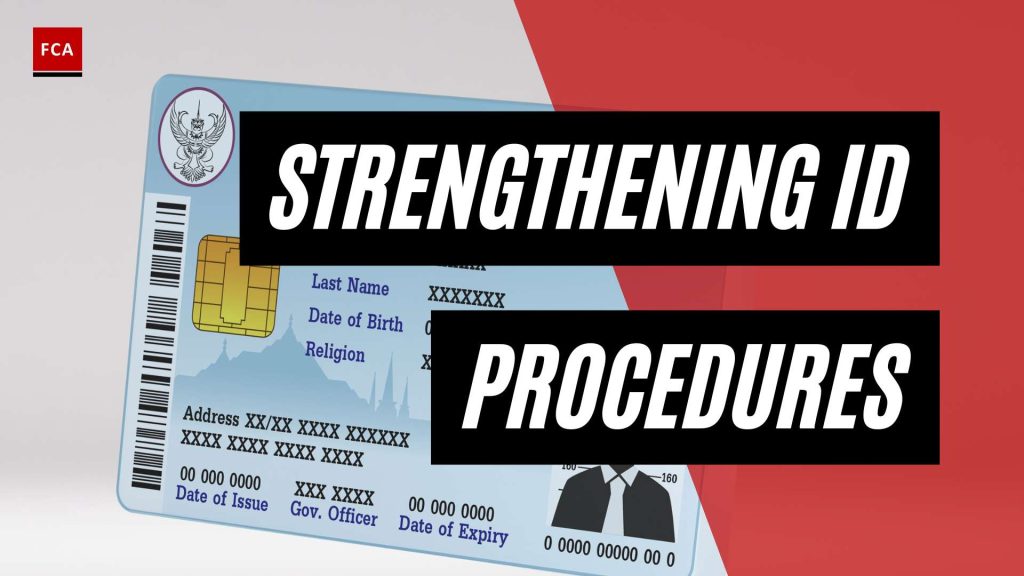Understanding Customer Identification Programs
Customer Identification Programs (CIPs) play a crucial role in the prevention of money laundering and the overall risk management efforts of financial institutions. A well-designed and implemented CIP helps institutions verify the identity of their customers, ensuring compliance with regulatory requirements and mitigating the risks associated with fraudulent activities.
The Importance of Customer Identification Programs
A robust CIP is essential as money laundering schemes often involve individuals posing as legitimate customers who aim to remain unidentified. The concept of “Know Your Customer” (KYC) emphasizes the importance of financial institutions having a reasonable belief, based on due diligence, that their customers are genuine and operating within the legal framework (LowerRiskGroup).
By implementing a thorough CIP, financial institutions can:
- Safeguard against money laundering and terrorist financing activities.
- Comply with regulatory requirements, such as the Bank Secrecy Act (BSA) and anti-money laundering (AML) laws.
- Establish a framework for risk assessment and customer due diligence.
- Maintain the integrity of the financial system and protect against reputational damage.
Components of a Customer Identification Program
A comprehensive CIP consists of several key components that work together to ensure effective customer identification and due diligence. These components may vary in complexity based on the size, risk profile, and business lines of the financial institution. The three essential elements of a CIP are:
-
Planning and Implementation: This component involves developing a written CIP document that undergoes management review and can be subject to enforcement actions. The CIP should outline risk-adjusted procedures for verifying customer identity, considering factors such as account types, transaction sizes, customer-provided information quality, and transaction locations (LowerRiskGroup). It is crucial to have clear protocols and procedures in place to guide employees in the identification and verification process.
-
Oversight and Accountability: Financial institutions should establish oversight mechanisms to ensure the effectiveness of their CIP. This includes assigning responsibility to designated personnel for overseeing the implementation and ongoing adherence to the program. Regular training programs should be conducted to keep personnel updated on the latest regulatory requirements and best practices related to customer identification. Additionally, a risk-based approach to customer due diligence should be adopted, considering information available about the customer type, service, and product (FDIC).
-
Independent Auditing: To ensure the integrity and effectiveness of the CIP, independent auditing is crucial. Regular audits should be conducted to assess compliance with the established protocols and procedures. The audit process should include a review of customer files, verification systems, and any suspicious transaction reports. This helps identify any weaknesses or gaps in the CIP and allows for timely adjustments and improvements to the program (LowerRiskGroup).
By incorporating these components into their CIPs, financial institutions can establish a strong foundation for customer identification and due diligence. This, in turn, enables them to comply with regulations, mitigate money laundering risks, and protect their reputation while maintaining the integrity of the financial system.
Implementing Effective Customer Identification Programs
To effectively combat money laundering and adhere to regulatory requirements, financial institutions and other organizations need to implement robust customer identification programs (CIPs). These programs play a vital role in verifying the identity of customers and detecting potential risks. Implementing an effective CIP involves clear protocols and procedures, verification systems for customer data, and independent audit processes.
Clear Protocols and Procedures
A successful CIP starts with clear and comprehensive protocols and procedures. These guidelines outline the steps that employees must follow when verifying customer identities. The protocols should be documented and easily accessible to ensure consistent implementation across the organization.
The protocols and procedures should consider factors such as account types, transaction sizes, customer-provided information quality, and transaction locations (LowerRiskGroup). By tailoring the procedures to the risk level and business lines of the institution, organizations can effectively identify potential money laundering risks.
Verification Systems for Customer Data
Implementing a reliable verification system is crucial for customer identification programs. This system should incorporate advanced identity and ID verification tools to combat fraud and ensure accurate identification. AI-enhanced document collection, data extraction, and analysis can enhance the efficiency and accuracy of the verification process (Lightico).
The verification system should allow for instant and remote customer eSignatures and consents. This reduces the need for in-person interactions, making the process more convenient for customers while ensuring compliance with anti-money laundering (AML) regulations.
Independent Audit Processes
To ensure the effectiveness of a customer identification program, independent audit processes should be established. These audits provide an objective evaluation of the program’s compliance with regulatory requirements and its overall effectiveness in mitigating money laundering risks.
Regular audits help identify any gaps or weaknesses in the program and provide recommendations for improvement. The audit process should be conducted by qualified individuals or external auditors who have expertise in AML compliance.
By implementing clear protocols and procedures, verification systems for customer data, and independent audit processes, organizations can enhance their ability to identify and mitigate money laundering risks. These measures not only help protect the institution and its customers but also contribute to a more secure financial environment overall.
Benefits of Customer Identification Programs
Implementing effective customer identification programs brings various benefits to businesses. These programs not only help in meeting regulatory requirements but also provide valuable insights into customer behavior and preferences. Let’s explore the key benefits of customer identification programs:
Enhancing Customer Engagement
Customer identification programs enable businesses to gather and analyze customer data, allowing them to gain a deeper understanding of their target audience. By leveraging this data, businesses can create personalized experiences and tailor their products and services to meet customer needs effectively. This, in turn, enhances customer engagement and strengthens the relationship between businesses and their customers. According to Business News Daily, businesses can utilize customer identification programs to stay attuned to evolving customer preferences and market trends, helping them remain competitive in the marketplace.
Improving Customer Satisfaction
By implementing customer identification programs, businesses are better equipped to provide personalized experiences to their customers. With a thorough understanding of customer preferences and behavior, businesses can anticipate customer needs and deliver targeted solutions. This level of personalization helps improve customer satisfaction and loyalty. When customers feel understood and valued, they are more likely to develop a long-term relationship with the business.
Personalized Marketing Campaigns
Customer identification programs allow businesses to create personalized marketing campaigns that resonate with specific customer segments. By analyzing customer data, businesses can identify patterns, preferences, and behaviors, enabling them to design targeted marketing strategies. Personalized marketing campaigns have been shown to increase conversion rates and deliver higher return on investment (ROI). According to Business News Daily, leveraging data collected through customer identification programs can significantly enhance the effectiveness of marketing efforts.
In summary, customer identification programs offer several benefits to businesses. They enhance customer engagement, improve customer satisfaction, and enable personalized marketing campaigns. By implementing these programs, businesses can gain valuable insights into their customers, tailor their offerings, and build stronger relationships, ultimately driving growth and success.
Challenges in Customer Identification Programs
Implementing effective customer identification programs comes with its fair share of challenges. Financial institutions and organizations need to navigate these challenges to ensure compliance, maintain security, and deliver a positive customer experience.
Balancing Security and Customer Experience
One of the primary challenges in customer identification programs is striking a balance between security needs and the customer experience. While robust Know Your Customer (KYC) processes are necessary to mitigate risks and prevent financial crimes, stringent verification procedures can potentially deter customers due to the inconvenience caused by lengthy processes (Regula Forensics).
To address this challenge, organizations can leverage advanced technologies and automation to streamline the verification process without compromising security. Implementing user-friendly interfaces and intuitive workflows can also help enhance the customer experience while ensuring compliance with regulatory requirements.
Compliance with Evolving Regulations
Compliance with evolving regulations poses another significant challenge for customer identification programs. Financial institutions must stay up-to-date with the latest anti-money laundering (AML) and KYC regulations to prevent financial crimes and protect themselves from penalties and reputational damage.
To navigate this challenge, organizations need to establish robust AML policies and procedures, regularly monitor regulatory changes, and adapt their customer identification programs accordingly. Collaborating with regulatory bodies and financial intelligence units can also provide valuable insights and guidance for compliance.
Staying Ahead of Technological Advancements
The rapid pace of technological advancements presents an ongoing challenge for customer identification programs. As fraudsters and money launderers continually adapt their techniques, organizations must stay ahead of the curve to effectively authenticate customer identities and detect suspicious activities (Regula Forensics).
To address this challenge, organizations should leverage advanced technologies like artificial intelligence and machine learning to enhance their fraud detection capabilities. Implementing robust transaction monitoring systems and leveraging data analytics can help identify patterns and anomalies indicative of illicit activities.
By addressing these challenges head-on, organizations can ensure the effectiveness of their customer identification programs, maintain compliance with regulations, and safeguard against financial crimes. It is essential to continuously evaluate and adapt these programs to meet evolving regulatory requirements and technological advancements.
Ensuring Data Privacy and Security
When implementing customer identification programs, ensuring data privacy and security is of utmost importance. Businesses must comply with data privacy regulations, establish clear policies and procedures, and maintain a comprehensive data inventory.
Compliance with Data Privacy Regulations
Compliance with data privacy regulations is essential to protect the personal information of customers. Regulations such as the General Data Protection Regulation (GDPR), California Consumer Privacy Act (CCPA), and Health Insurance Portability and Accountability Act (HIPAA) require businesses to handle personal data responsibly and implement measures to safeguard privacy.
To comply with data privacy regulations, businesses must understand and adhere to the specific requirements and obligations outlined in each regulation. This includes obtaining proper consent for data collection, implementing security measures to protect personal data, and providing individuals with the right to access, correct, or delete their personal information.
Clear Policies and Procedures
Developing clear policies and procedures is crucial for ensuring compliance with data privacy regulations. These policies should govern the collection, processing, and storage of personal data, and should be communicated, reviewed, and updated regularly to remain effective.
By establishing clear policies and procedures, businesses can ensure that employees understand their roles and responsibilities in protecting personal data. These policies should outline the steps to be taken in case of a data breach or security incident and should provide guidelines for handling and sharing customer information.
Comprehensive Data Inventory
Creating a comprehensive data inventory is an important step in ensuring data privacy and security. This involves identifying all personal data that is collected, processed, and stored by the business. A data inventory helps businesses assess the risks associated with data collection and ensures compliance with data privacy regulations (LinkedIn).
A comprehensive data inventory should include details such as the types of personal data collected, the purposes for which it is collected, the sources of data, and the parties with whom the data is shared. By maintaining an up-to-date data inventory, businesses can better understand the data they possess and implement appropriate security measures to protect it.
To further enhance data privacy and security, businesses should train employees on data privacy policies and procedures, conduct regular audits to review the effectiveness of these policies, and ensure that all necessary measures are in place to protect customer data. By prioritizing data privacy and security, businesses can build trust with their customers and mitigate the risks associated with unauthorized access or data breaches.
Key Considerations in KYC Compliance
To effectively combat money laundering and ensure regulatory compliance, financial institutions and other entities must implement robust and thorough customer identification programs. Key considerations in KYC (Know Your Customer) compliance include gathering and verifying customer information, conducting risk-based customer due diligence, and maintaining accurate and updated information.
Gathering and Verifying Customer Information
KYC regulations require companies to collect a minimum of four pieces of data for identity verification: name, date of birth, address, and identification number. The specific methods of collecting this information may vary, ranging from in-person submissions to online verification systems that utilize digital documents and biometric data.
Financial institutions should identify the types of information they require from each customer, ensuring that the level of diligence is commensurate with the risks posed by each customer. Gathering and verifying customer information is crucial in establishing the customer’s identity and assessing potential money laundering risks.
Risk-Based Customer Due Diligence
Risk-based customer due diligence (CDD) is an essential component of effective KYC compliance. Financial institutions should evaluate the risk profile of each customer to determine the appropriate level of due diligence necessary for ongoing monitoring. By conducting risk assessments, institutions can tailor their KYC procedures to better identify and mitigate potential money laundering risks.
CDD measures may include enhanced due diligence for higher-risk customers, such as politically exposed persons (PEPs) or customers engaged in certain high-risk activities. These measures help institutions establish a comprehensive understanding of their customers and their transactions, ensuring compliance with anti-money laundering (AML) regulations.
Maintaining Accurate and Updated Information
To maintain KYC compliance, financial institutions must prioritize the accuracy and currency of customer information. Institutions should establish policies and procedures to ensure that any changes in customer risk profiles are promptly identified and monitored. Regularly updating customer information allows institutions to adjust their CIPs (Customer Identification Programs) as necessary, ensuring ongoing compliance with evolving regulations (FDIC).
By maintaining accurate and updated customer information, financial institutions can effectively monitor customer activity, detect suspicious transactions, and mitigate the risks of money laundering. This attention to detail and diligence in customer data management contribute to the overall effectiveness of KYC compliance.
Implementing thorough customer identification programs that encompass gathering and verifying customer information, conducting risk-based customer due diligence, and maintaining accurate and updated information is crucial for preventing money laundering and ensuring compliance with AML regulations. By adhering to these key considerations, financial institutions can strengthen their defenses against money laundering risks and protect the integrity of the global financial system.
Mitigating Money Laundering Risks
One of the primary objectives of customer identification programs, also known as Know Your Customer (KYC) regulations, is to prevent money laundering and terrorist financing. Financial institutions and governments have implemented these programs to ensure compliance with Anti-Money Laundering (AML) regulations and to safeguard the integrity of the financial system (Regula Forensics). In this section, we will explore three key elements in mitigating money laundering risks through effective customer identification programs.
Strong Risk-Mitigation Controls
Financial institutions must establish strong risk-mitigation controls to prevent or mitigate the risks associated with money laundering, terrorist financing, and other illicit activities (FDIC). These controls include robust customer due diligence procedures and enhanced monitoring.
Customer due diligence involves collecting and verifying information about the customer’s identity, address, and financial transactions, in accordance with KYC regulations (Regula Forensics). By conducting thorough due diligence, institutions can assess the risk profile of their customers and identify any suspicious activities. This process helps ensure that only legitimate customers are onboarded and that potential risks are identified and managed effectively.
Enhanced monitoring is another essential component of risk-mitigation controls. It involves ongoing monitoring of customer transactions, behavior, and patterns to detect any unusual or suspicious activities. By implementing transaction monitoring systems and employing advanced analytics, financial institutions can identify potential red flags and take appropriate action to mitigate the risks associated with money laundering.
Preventing Illicit Activities
Customer identification programs aim to prevent illicit activities, such as money laundering and terrorist financing. To achieve this, financial institutions must implement effective measures to detect and deter these activities.
One crucial aspect of prevention is conducting thorough sanctions screening to identify individuals or entities involved in illegal activities. Financial institutions should screen their customers against global sanctions lists and politically exposed persons (PEPs) databases to ensure compliance with relevant regulations and prevent illicit funds from entering the financial system.
Another important measure is the implementation of suspicious transaction reporting mechanisms. Financial institutions should have clear policies and procedures in place to identify and report any transactions that appear suspicious or unusual. This helps in the early detection of potential money laundering activities and facilitates the sharing of information with relevant authorities and financial intelligence units.
Compliance with AML Regulations
Compliance with AML regulations is a fundamental requirement for customer identification programs. Financial institutions must adhere to the specific requirements set forth by regulatory bodies to ensure the effectiveness of these programs.
AML regulations vary across jurisdictions, and financial institutions must stay abreast of the evolving landscape to remain compliant. They must establish and maintain robust AML policies and procedures that address the specific requirements of the jurisdictions in which they operate. This includes conducting risk-based customer due diligence, ongoing monitoring, and reporting suspicious activities as mandated by applicable AML laws and regulations.
By actively ensuring compliance with AML regulations, financial institutions can contribute to the prevention of money laundering, terrorist financing, and other illicit activities. Regular training and awareness programs for employees can help reinforce the importance of compliance and ensure that all staff members understand their roles and responsibilities in mitigating money laundering risks.
Mitigating money laundering risks requires a comprehensive and proactive approach. Financial institutions must establish strong risk-mitigation controls, prevent illicit activities through effective screening and reporting mechanisms, and ensure compliance with AML regulations. By implementing these measures, institutions can contribute to a safer financial environment and protect against the misuse of the financial system for criminal purposes.
Addressing Common KYC Challenges
Implementing effective customer identification programs (CIP) is crucial in the fight against money laundering and financial crime. However, there are several challenges that organizations face when it comes to KYC implementation. In this section, we will address three common challenges and explore strategies to overcome them.
False Positives and Reputational Damage
False positives are a major challenge in KYC implementation. They occur when legitimate customers are incorrectly flagged as suspicious, leading to delays in onboarding and potentially causing reputational damage to the organization. To mitigate this challenge, organizations should leverage multiple data sources and employ advanced technologies to improve the accuracy of identity verification.
By incorporating machine learning algorithms and predictive scoring, organizations can prioritize alerts for fraud and AML teams, focusing on critical areas that require attention. Additionally, incorporating human reviews into the identity verification process can help reduce false positives and ensure accurate decision-making. It is essential to strike a balance between effective risk management and providing a smooth customer experience.
Automation for Speed and Accuracy
Automation plays a vital role in addressing the challenges associated with manual KYC processes. By leveraging technology, organizations can enhance the speed and accuracy of identity verification while minimizing the risk of human error. Automation allows for the efficient processing of large volumes of customer data, reducing the time required for onboarding and improving operational efficiency.
Machine learning algorithms and artificial intelligence can be employed to analyze customer data, identify patterns, and detect anomalies that may indicate potential risks. This enables organizations to streamline their KYC processes and focus their resources on higher-risk customers or transactions. Automated systems also facilitate regular updates of customer information, ensuring that KYC records are accurate and up to date.
Regulatory Compliance with KYC Requirements
Staying compliant with evolving KYC regulations is a continuous challenge for organizations. Financial institutions are required to gather and retain specific customer information to meet regulatory requirements, such as the “know your customer” (KYC) rule introduced by the Financial Industry Regulatory Authority (FINRA) (Unit21). To address this challenge, organizations should establish robust AML policies and procedures that align with regulatory guidelines.
Regular training and awareness programs should be conducted to ensure that employees are well-informed about the latest KYC requirements and best practices. It is also crucial to establish ongoing monitoring and review processes to identify any gaps in compliance and promptly address them. By staying proactive and staying abreast of regulatory changes, organizations can ensure continuous adherence to KYC requirements.
Addressing these common KYC challenges requires a combination of technological advancements, a risk-based approach, and a commitment to ongoing compliance. By implementing effective solutions to overcome these challenges, organizations can strengthen their customer identification programs, enhance risk management capabilities, and contribute to the fight against money laundering and financial crime.








